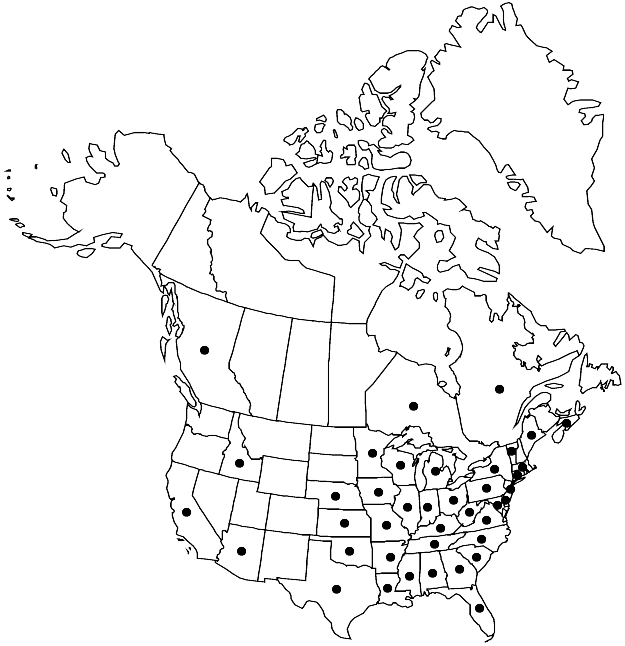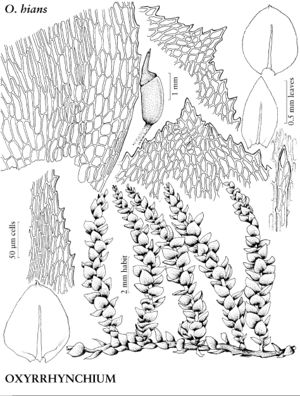Oxyrrhynchium hians
Verh. Bot. Vereins Prov. Brandenburg 49: 59. 1907.
Plants glossy. Stems 3–10 cm, branches 4–12 mm. Stem leaves broadest at 1/7–1/3 leaf length, 0.7–1.3 × 0.5–0.8 mm; alar cells 12–20 × 10–15 µm, region small, conspicuous, pellucid; laminal cells (25–)40–60(–80) × 5–7 µm; basal juxtacostal cells 7–10 µm wide. Branch leaves 0.8–1.1 × 0.4–0.7 mm. Seta 1–2.5 cm. Capsule 2 mm.
Habitat: Soil, open humus in forests, rock, rotten logs, tree bases, mesic to wet conditions, deep shade to sunny places
Elevation: low to moderate elevations (0-800 m)
Distribution

B.C., N.S., Ont., Que., Ala., Ariz., Ark., Calif., Conn., Del., Fla., Ga., Idaho, Ill., Ind., Iowa, Kans., Ky., La., Maine, Md., Mass., Mich., Minn., Miss., Mo., Nebr., N.J., N.Y., N.C., Ohio, Okla., Pa., S.C., Tenn., Tex., Vt., Va., W.Va., Wis., Europe, Asia, Africa, Atlantic Islands.
Discussion
Oxyrrhynchium hians is a highly variable species; it ranges from densely foliate, almost tumid phenotypes to very remotely and complanate-foliate plants in shaded habitats. Leaves vary from broadly elliptic and sometimes almost orbicular to narrowly ovate-triangular. In Florida, plants with multispinose costae were described as O. rappii. However, R. S. Breen (1963) found this character to be unstable, sometimes varying along a single stem; H. A. Crum and L. E. Anderson (1981) agreed that this name refers to no more than a form of O. hians. Eurhynchium semiscabrum E. B. Bartram, known from Mexico and more southern countries, is similar to O. hians and may be found in southern states, especially in Florida. It differs from O. hians primarily in its synoicous sexual condition. Despite a broad distribution in the East and its somewhat weedy nature, O. hians is mostly absent in the West. It has been found there only twice, in Vancouver, British Columbia, and in California, growing in lawns, and should be considered a fairly recent introduction.
Selected References
None.
